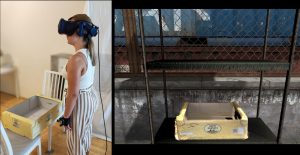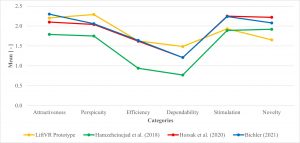Analysis, Development and Evaluation of a 3D Scanning Process for Physical Objects to Assess Workplace Conditions When Lifting, Holding And Carrying Loads in a Virtual Reality Prototype
Aim and Research Question(s)
The purpose of this thesis was to analyse, develop and evaluate a 3D scanning process for physical objects to assess workplace conditions when lifting, holding and carrying loads and training those in a virtual reality prototype (LiftVR). Therefore, the following two research question were defined: (1) What are the optimal parameter configurations when scanning a real object using a specific LIDAR scanner application and how is the usability of this application evaluated? (2) How is the user experience of a developed virtual reality prototype with real world object tracking evaluated?
Background
Prevention strategies can help people live a longer healthy life [1]. Besides physical exercises and psychosocial care an important segment of health promotion are ergonomics. One way to minimize risks for future health problems is ergonomic training [2]. Methods to support motivation during training that have been proven to be effective in other fields of the healthcare sector are VR-based interventions [3], [4].
Methods

Figure 1: LiftVR Prototype
First, a literature review was conducted. Second, 3D scanner applications for iOS devices were evaluated.
Third, the LiftVR prototype was developed, which allows real-time tracking of objects.
Lastly, user tests were performed to evaluate the
usability of the 3D scanner app with the System Usability Scale (SUS) and the user experience of the prototype with the User Experience Questionnaire (UEQ).
Results and Discussion
- The application was very complex due to the large number of configuration options. Nevertheless, the usability of the application was ensured by detailed step-by-step instructions, as shown by the high SUS score of 75.1.
- The results of the UEQ show similarly good values in comparison with other VR applications [5], [6], [7].

Figure 2: UEQ Benchmark Comparison of the Mean for the Six Areas
Conclusion
The 3D Scanner application and the LiftVR prototype showed promising results and good applicability for the given use cases. Future work could deal with the evaluation of the applications in a real life scenario for ergonomic training.
References
[1] 10.7759/cureus.17109;
[2] 10.21934/BAUA:BERICHT20191203;
[3] 10.3390/ijerph17072592;
[4] 10.5014/ajot.2020.041442;
[5] 10.1109/VR.2018.8446125;
[6] 10.1016/j.gaitpost.2020.07.113;
[7] B. Bichler, ‘Design, prototypical development and evaluation of a virtual reality-based game for training activities of daily living for people provided with a lower limb prosthesis’, May 2021.